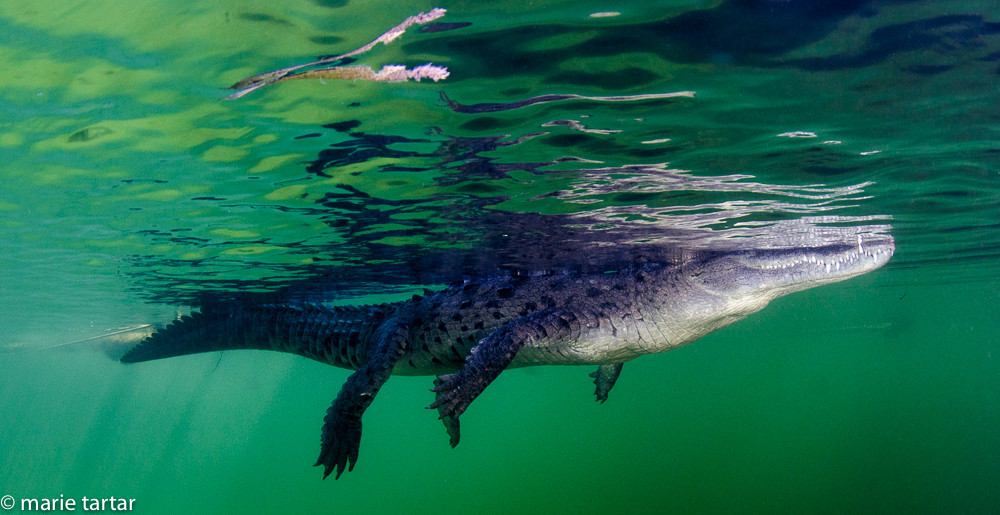
Saturday, July 18, 2015
Getting to our dive destination was a long wearying travel day, in which we crossed from the north coast to the south, and traversed much of Cuba’s crocodile-shaped length as well. It began at 3:15 am, rising to finish packing in order to assemble in the lobby at 4 am. This proved unnecessarily early, as the bus had to gather up people from a few other hotels before finally pulling up at 5:15 am.
Most people dozed on the 6+ hour journey, but sleep eluded me on the frosty cold bus. Traversing the verdant countryside , we regularly passed donkey-drawn carts, cows grazing, and fields of sugarcane, punctuated periodically by billboards with propaganistic proclamations on the order of: “Cienfuegos: Tambien es un pueblo revolutionario!”

I couldn’t bring myself to photograph the drab buildings in Plaza de la Revolución, 5 story tall likeness of Che or no; same for most of the propagandist billboards; this colorful graffiti depiction of Che was taken in Havana Vieja
Finally arriving at the dock in Jucayo on the south coast, we were on to the final leg, boarding a boat for a 3-hour-tour. Yes, a 3-hour-tour, arriving not to Gilligan’s Island, but to an array of floating barges, forming an aquatic city. Avalon, the parent company, is Italian, and joint ventures with the Cuban government to be the exclusive provider of dive services in Jardines de la Reina (gardens of the Queen). They have 6 boats. Our boat, Tortuga, is a floating barge hotel with 8 cabins.
Other boats appear more typical of live-aboard dive boats. Barges serve as dive lockers, and garages for skiffs. Our gear is left on a skiff large enough to hold 11 of us, with a Russian family of 3 (parents and their 15 year old son) assigned to a separate smaller boat.
After our late lunch at 3:30, the rest of the day was devoted to assembly of dive rigs, and the more painstaking, multi-step building of the underwater cameras.
Sunday, July 19, 2019
Gardens of the Queen, or “Sharks and groupers and crocodiles, oh my!”
My first day of diving was excruciating in many ways. I don’t think I ever realized quite so acutely how effortless, pain-free depth adjustment was so essential to underwater photography. That I was able to dive at all was gratifying. While at lunch at Otra Manera the prior Wednesday, I had suddenly developed a sore throat, and had been battling the subsequent days’ progression of sneezing, running nose, and coughing with round-the-clock Pseudofed.
But, the morning of our first day, I felt clear enough to give it a try.
Pius Reef: It was a struggle to descend. Two feet down, one foot back up, trying to relieve the screaming in my right ear. It was torture. Changing depth quickly was out of the question. Noel hung back with me as the rest of the group descended out of sight, dematerializing into amorphous streams of bubbles. Eventually, I managed to make it to 25 feet. A Hawksbill turtle we sighted below us seemed to be on a trajectory toward me, but meet it, I could not. It was the same with a nurse shark resting on the sandy bottom. The 15 feet of additional descent was too painful.
Octopus Cave: The prospect of Caribbean reef sharks was enough to entice me back into the water for the 11 am dive, but it was even slower going trying to descend the first 10 feet, where the change in pressure is the greatest. It took me 10 painful minutes to break the 10 feet depth mark, and another 10 minutes to break 20 feet. I was motivated by seeing abundant yellow schools of grunts and goatfish hovering around a miniature point below me. The boat was tied to a mooring, so there was no question of getting lost as the group descended and disappeared in the murk of distance.
After a while, I could see Greg and Steve about 30 feet below me on the sandy bottom, engaged in a waiting game with large groupers.
The rest of the group materialized across the sandy plane on an extension of the bench on which I had been stranded.
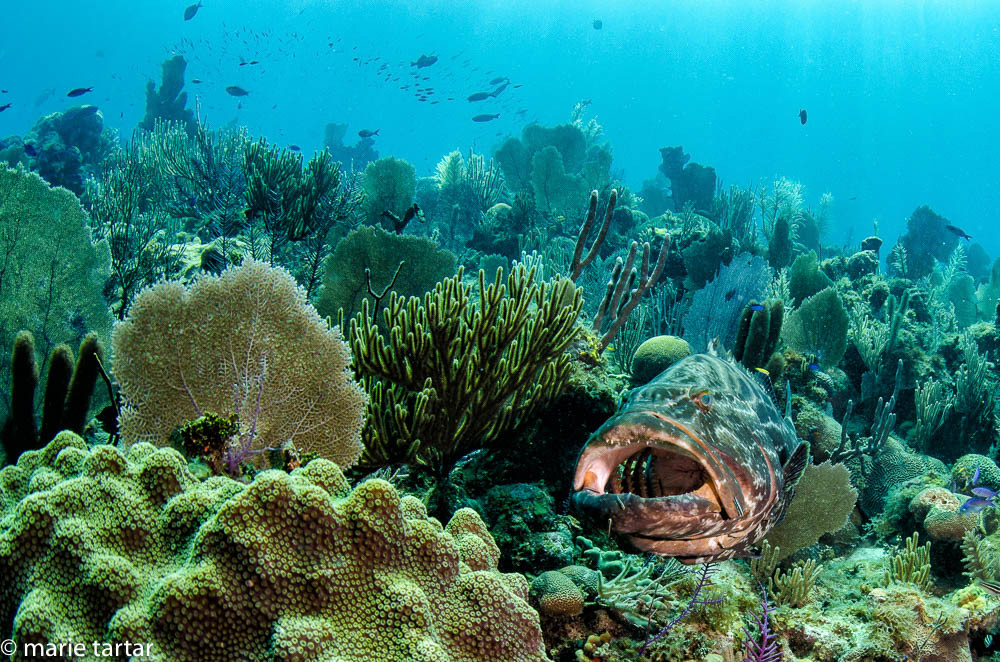
“Open wide, this won’t hurt a bit.” Grouper being cleaned by a small army of cleaners. Marine animals being cleaned can often be closely approached.
The giant groupers were approachable, and impressive and healthy-looking silver Caribbean reef sharks shot by. To see a grouper being groomed by a small army of attendants, see: https://vimeo.com/136404985
A pair of huge remoras swam energetically and mildly menacingly around the ascending divers. Having once been targeted by a remora, which latched on to my calf during a dive, only disengaging while ascending the ladder, I eyed them askance.
To give my ear a chance to recuperate, I sat out the afternoon dive, another coral reef setting (Finca de Pepe).
Monday, July 20, 2015
El Farallon: I made my way down a mooring line slowly to a cliff-top coral reef at 65 foot depth. The group disappeared in the distance while I inched my way down, but reappeared about the time I made it down. Down near the reef, Caribbean reef sharks skirted the group, coming tantalizingly close for good looks, but not really close enough for good shots.
Tony had said during the briefing that the silky sharks would come in during our safety stop, and they did. They wheeled languidly around us near the surface. I could hardly pull myself out of the water.
The Caribbean and silky sharks are similar in appearance, with the Caribbean having rounder heads compared with the pointier profile of the silkys.
To swim with silky sharks vicariously, here’s a video clip: https://vimeo.com/136365456
Five Sea: A bait box descended with us, releasing enticing scents into the water current. This was first positioned on a coral flat at about 35 foot depth, and then repositioned deeper, around 65 feet. Caribbean reef sharks soon were circling the box, as were sizable groupers. We spun around and around too, in a dizzying confusion of divers, bubbles, sharks, and groupers. Tarpon hovered in a line below a small ledge nearby.
To experience this type of shooting session vicariously, here’s a video link: https://vimeo.com/136365452
Tony led most of the group further on after a while, leaving Steve, Greg and me with Noel, to shoot, watch and videotape the circling sharks to our heart’s content.
Tuesday, July 21, 2015
Instead of a one-tank dive, returning to Tortuga in between, we headed out for the entire morning, with a snorkel and beach excursion between the 2 dives.
The first dive, Black Coral, was crazy! I was pleasantly nearly unimpeded by my ears and able to descend at a much more normal pace. As the box of bait came into focus down below, a frenzy of sharks were circling it wildly. The area quickly became stirred up with sand and sediment.
As we approached a white sand beach for our surface interval, a small army of iguanas swarmed toward us, a reptilian greeting party.
Chipmunk-like brown furry rat-relatives (but much cuter) called hutias huddled under the shade of bushes bordering the beach.
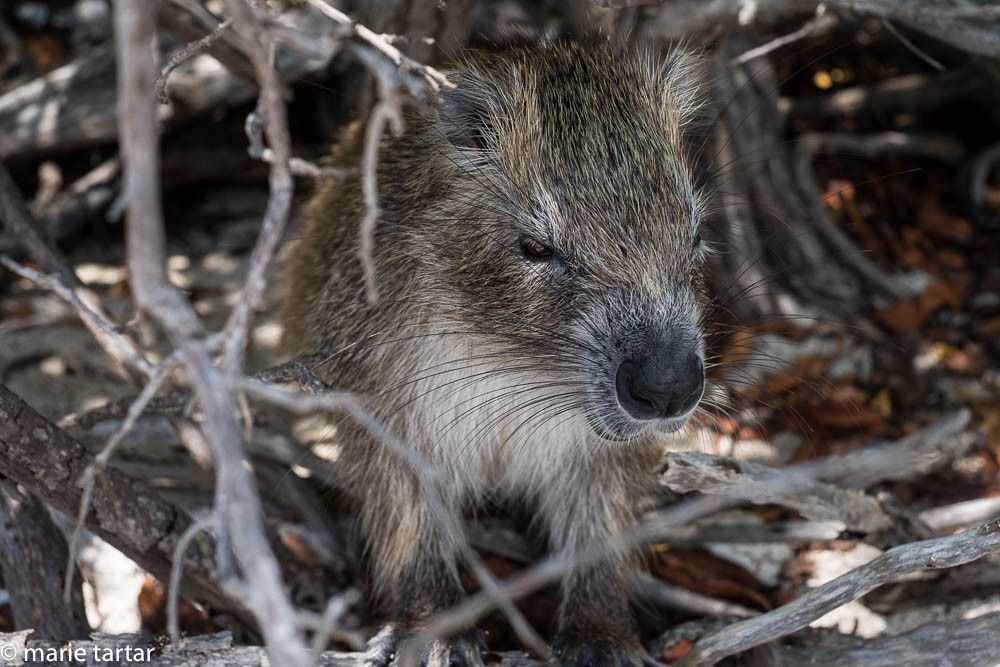
Unusually cute for a rat cousin, hutias derive necessary fluids from fruits and solid foods, but will drink from a proffered water bottle
Snapper Head: For the second dive, my ears reverted back. I was able to descend, but only so slowly, until about 30 feet. Then my previously asymptomatic right ear began to chime in. I shadowed Noel from on high, as he brought up the rear of a group drift dive from one buoy to another.
Javier and I sat out the last dive, chatting on the front deck. Tito the crocodile appeared at the corner of the barge, lounging on the mooring ropes. As we chatted, the divers returned and a few minutes later, Greg, Steve and Bob appeared in the water below us, closing in on Tito. Lying flat on the deck, we could peer at the crocodile, which appeared unperturbed at the divers’ presence.

Tito was a regular afternoon visitor to Tortuga, lounging often on the mooring ropes tethering the corners of the barge
A second wave of snorkelers (Cindi and Cindy) was gearing up on the back deck. I was surprised at the lack of supervision. “Any special instructions given on the boat?” I asked. “No, wear black. Don’t touch it. Keep your camera between you and the croc. You can approach its face closely.”
However, the boat was gone, off refilling the tanks, with my snorkeling gear. Lori volunteered her mask and snorkel. As I checked my camera over, I found I could not turn it on. I had had difficulty earlier in the week, while assembling the camera. Sometimes, the left hand controls (the zoom gear and the autofocus selector) worked, but not the on-off switch, and sometimes the reverse. But, the on-off switch had been working perfectly earlier and I hadn’t opened the camera since, so nothing should have changed. Frustrated as could be, I took the back off the camera. Thankfully, before I had the dome port off and the camera out, the on-off switch worked again. By this time, Cindi and Cindy had returned and Cindi volunteered her snorkel fins. I considered going without fins and was discouraged by her:
“The current will push you into the croc and you’ll want fins to keep your distance.”
This was how I ended up in the water alone with Tito the croc. Everyone who was going had emerged from the water. Tito was still at the corner of the back deck. The water was green with algae. Rounding the corner of the boat, the long black shape dominated the far corner. As Cindi had indicated, it was indeed difficult not to bump up against the croc. I didn’t want to do anything to alarm the beast. As it was, I was shaking, but not from cold ( the water temperature was the warmest I’ve ever dove in, 87 degrees F by my computer, and in the shallow lagoon, it was a lukewarm Jacuzzi). Peering around the barrier of my underwater rig, it was terrifying being eye to eye with the scaly and toothy creature, but it appeared quite indolent.
I got a few frames off before Tito stirred and slipped away from under the deck, heading toward another boat. I retreated to the far corner of the deck, opposite its favored spot, to see if it might return. Which it did, but only long enough for one additional frame, before it again beat a retreat toward the other boat. At that point, I gave up. Of course, by the time I rinsed my creature of the black lagoon coating off, Tito had reassumed his favorite lounging posture on the mooring rope.
Wednesday, July 22, 2015
“Nino!” Heavy-set Noel can really bellow.
“Nino!” Despite his cajoling, his vocal efforts were for naught. No crocodile materialized as planned for our between morning dives interlude.
Can crocodiles actually be summoned by calling? We didn’t witness this working on this occasion. It was time for our second dive.
The first (Los Indios) had been a frenzy of sharks, with the baited box again attracting great attention by the Caribbean reef sharks and a variety of sizable groupers, namely Nassau and black.
My ears cooperated, letting me descend to the depths without too much protest. As before, when the bait box ascended, the sharks followed, swirling around us in the water column. They are so beautiful, mesmerizing to watch. As usual, I am the last to exit the water, hardly able to tear my eyes away from these gorgeous creatures.
On the second dive, Los Mogotes, my ear difficulty again prevented me from descending quickly. Eventually, I was able to work my way down, very slowly, to 40 foot. I had been watching Noel, Steve and Greg with the bait box, sharks and groupers, on a large coral bommie island in a flat of sand, the rest of the group having taken off with Tony for a swim through the area. This was the usual format of our shark dives, the whole group descending with the bait box, watching the sharks come in, then most of the group being led away, leaving the photographers wanting more time with the sharks back with Noel and the bait box. Eventually, the group would return and the bait box would be levitated, leading the sharks to follow our ascent.
Stalking Tito alone: While getting ready for the afternoon dive, I noticed again that the camera was off, and could not be turned on. I decided to bag the dive. While still evaluating the camera, the boat returned briefly.
Steve: “Do you want to come and shoot with the Go-Pro?”
Me: “No.” Then they mentioned Tito the crocodile was at the front deck side of the barge.
I got the camera going again, and decided to stalk Tito while the divers were away. First, I checked the deck to confirm he was still there. Lori handed my camera down to me, and I headed down the length of the boat. Rounding the corner, Tito was no longer visible. I waited. Starting back for the dive deck, I caught sight of a tail down below. The end of the barge was undercut at a 45 degree angle, creating a shaded hideaway. Evidently, this was Tito’s hiding place, when in attendance but not resting in the open on the mooring lines. I hung on the surface, watching. Eventually, Tito surfaced and I floated out into the lagoon with him. Something bumped me from behind, and I jumped. It was a snorkeler from the other boat.
This was not the first time I had been spooked while alone with Tito. Although Tito never gave me any cause for concern, I was jumpy nevertheless, starting violently when I caught a glimpse of something out of the corner of my eye (a terrifying, blood red, tomato slice!), and when I backed into something on the water’s surface (a hefty and unyielding mooring line).
Thursday, July 23, 2015
Silky sharks were the star attraction of our first dive, Vincent. As promised, they materialized as we ascended. They were more closely approachable, especially just below the boat, occasionally bumping or nearly so into us.
Our surface interval was in the shallow lair of Nino, the no show crocodile of the prior day. Noel persisted, bellowing in a rich baritone:
“Ninoooooo!”
And again, “Ninooooooo, ven, ven!” (Nino, come, come!)
Just when it seemed Nino was MIA again, Noel pointed in the distance:
“He’s coming!”
To our amazement, there was in the distance a tiny black perturbation of the surface, which grew as we watched it into a recognizable half-submerged crocodile face.
Trying to shoot it in the water was a disaster. The boat was tied up to a post. On one side, there was less than one foot of water, with low sea grass and a thick layer of silt. The water was deeper and clearer on the other side, at least initially, until snorkelers in the water started flapping their fins and stirring it up. Unfortunately, Nino seemed disinclined to be induced from the shallow side. It was so shallow, it wasn’t possible to float, so even a slow approach resulted in the water being completely silted up.
As we prepared to pull away, I tried a last ditch effort, holding the heavy camera in its housing over the side of the boat, and focusing and shooting blind.
El Cabesode Las Rayas was a beautiful dive. In the top 20 feet of water were innumerable pulsating moon jellies.
My skin reacts so extremely to stinging particles in the water that I’m generally covered head to toe with neoprene, including hood and gloves, leaving only 1 inch circles of cheek uncovered by dive mask, hood or regulator. But we’d been told that these moon jellies were harmless, and indeed I had made it 4 days already with no red welts or uneven bee-stung, collagen-gone-awry lip mishaps, so I was able to relax and enjoy being surrounded by these ephemeral creatures. Yes, jellyfish scare me a lot more than sharks (not at all) and even crocs. The coral garden was studded with gorgeous large and colorful sponges.
Schools of yellow fish of every stripe wove their way through the waving sea fans. Indeed, I remarked to Steve on ascending that we’d just returned from the “happiest place on earth.” To visit this happy place vicariously by video, voila: https://vimeo.com/136365454
Our afternoon was equally idyllic, including a drift snorkel above a rare elkhorn coral stand dappled by the golden afternoon sun. Abundant sargeant majors and blue-striped grunts wove in and out the branches. Heaven on earth? It doesn’t get much better. Judge for yourself on this short video clip: https://vimeo.com/136365453
Coming soon…Part 4, Down and Out in Havana, in which Steve and I are unexpectedly detained in Havana for 3 extra days! Stay tuned…
-Marie

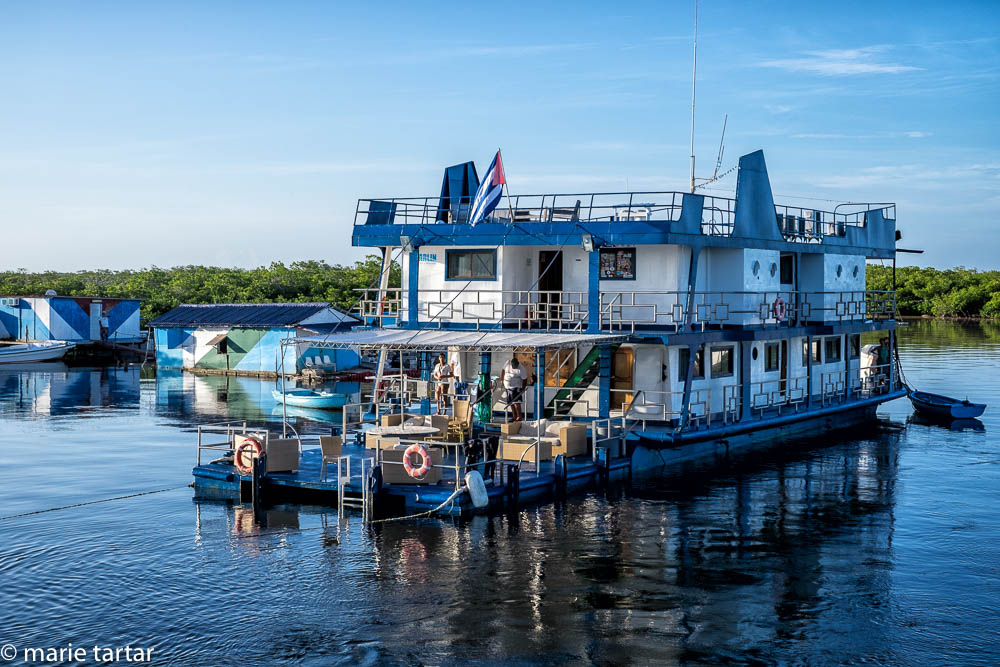
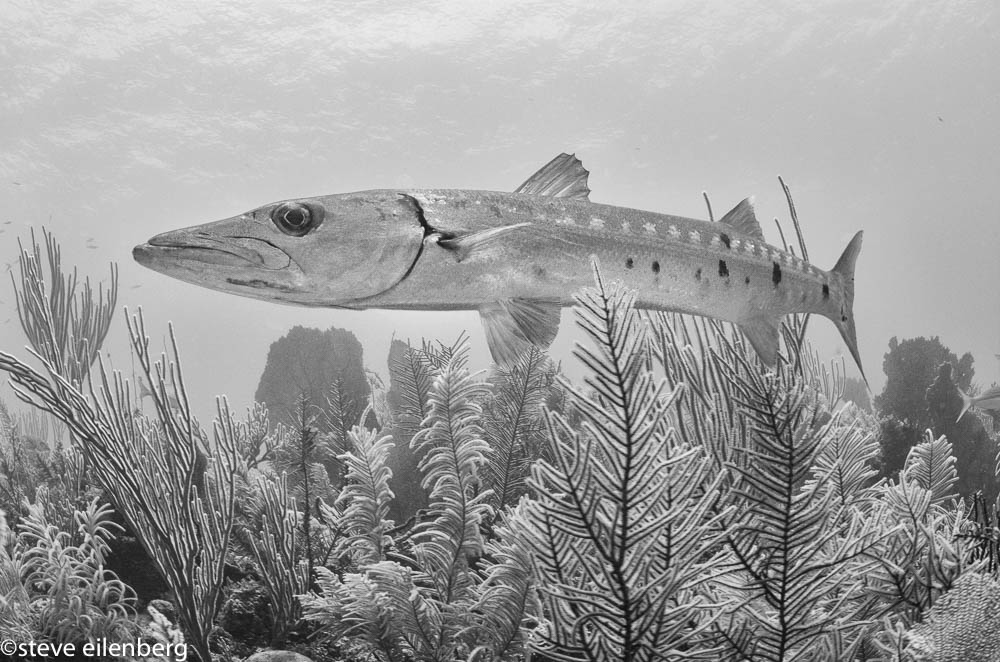












Each and every photograph is simply stunning eye candy, and your fun dialogue just as enjoyable. Thanks for sharing. Hugs, Renée & Terry
Spectacular images and what a site. Reminds me of the Great Barrier Reef, but with sharks and crocs. Thanks for sharing all this, Marie and Steve!
So love following your adventures and wonderful pictures. The crocs are enchanting.
i should be doing 100 other things, but once i start reading and the pictures, OMGosh i am hooked. Thanks for the stories, sorry about your ears and still think you are crazy to get in the water with a croc, but i am a happy reader. s
Thank you for vicarious dive trip experience. For a few minutes, I was there with you!
Marie,
Your story telling from our trip is superb! Your images and Steve’s are works of Art! Privileged to share this time with you!
Many thanks for this wonderful memory displayed so well!
Cindi